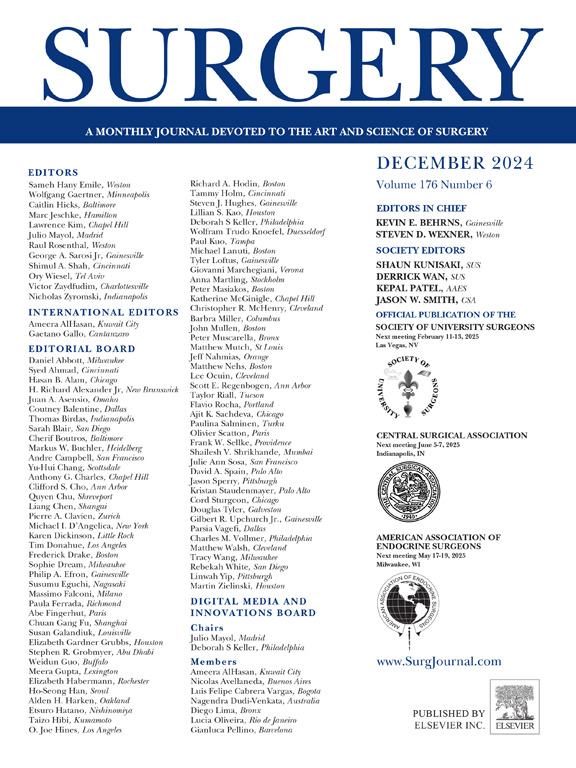A novel surgical classification system for ileocolic Crohn's disease: “It is not just ileocolic disease”
IF 2.7
2区 医学
Q1 SURGERY
引用次数: 0
Abstract
Background
Crohn’s disease (CD) often affects the terminal ileum, leading to complications such as stricture, fistula, and abscesses, necessitating surgery in up to 80% of patients. Early and effective treatment is crucial to prevent disease progression and improve outcomes, although timing between medical and surgical treatments is challenging.
Methods
This study reviewed patients who underwent ileocolic resection for CD at our quaternary inflammatory bowel disease center from September 2016 to September 2023. A novel classification system categorized the severity and complexity of ileocolic CD. Preoperative characteristics, operative variables, and postoperative outcomes were analyzed to assess the impact of disease complexity.
Results
Among the 301 patients (median age 33.3 years, 48.5% female), 56.8% had complex ileocolic CD. Complex disease was associated with greater blood loss, longer hospital stays, longer operative time, and greater rates of open surgery and conversion compared with noncomplex disease (P < .01). Diversion rates were significantly greater in complex cases (P < .01). Emergent operations were more common among complex cases (P < .01). Delayed referral and increased complexity correlated with inferior surgical outcomes and greater stoma rates.
Conclusion
The proposed classification system stratifies patients on the basis of CD severity and complexity, facilitating better preoperative planning and communication among multidisciplinary teams. Early surgical intervention, when appropriate, may reduce morbidity and improve outcomes in patients with ileocolic CD. This system highlights the importance of timely referrals and standardizing the management approach for complex CD.

一种新的回肠结肠性克罗恩病手术分类系统:“它不仅仅是回肠结肠疾病”
背景:克罗恩病(CD)经常影响回肠末端,导致并发症,如狭窄、瘘管和脓肿,80%的患者需要手术治疗。早期和有效的治疗对于预防疾病进展和改善预后至关重要,尽管内科和外科治疗之间的时间选择具有挑战性。方法本研究回顾了2016年9月至2023年9月在我们的第四期炎症性肠病中心接受回结肠切除术治疗CD的患者。一种新的分类系统对回结肠CD的严重程度和复杂性进行了分类。分析了术前特征、手术变量和术后结果,以评估疾病复杂性的影响。结果在301例患者中(中位年龄33.3岁,48.5%为女性),56.8%的患者患有复杂的回肠结肠CD。与非复杂疾病相比,复杂疾病与更大的出血量、更长的住院时间、更长的手术时间以及更高的开放手术和转归率相关(P <;. 01)。在复杂病例中,转移率明显更高(P <;. 01)。紧急手术在复杂病例中更为常见(P <;. 01)。延迟转诊和增加复杂性与较差的手术结果和较高的造口率相关。结论提出的分类系统根据CD的严重程度和复杂程度对患者进行分层,有助于更好的术前计划和多学科团队之间的沟通。在适当的情况下,早期手术干预可以降低回肠结肠CD患者的发病率并改善预后。该系统强调了及时转诊和规范复杂CD管理方法的重要性。
本文章由计算机程序翻译,如有差异,请以英文原文为准。
求助全文
约1分钟内获得全文
求助全文
来源期刊

Surgery
医学-外科
CiteScore
5.40
自引率
5.30%
发文量
687
审稿时长
64 days
期刊介绍:
For 66 years, Surgery has published practical, authoritative information about procedures, clinical advances, and major trends shaping general surgery. Each issue features original scientific contributions and clinical reports. Peer-reviewed articles cover topics in oncology, trauma, gastrointestinal, vascular, and transplantation surgery. The journal also publishes papers from the meetings of its sponsoring societies, the Society of University Surgeons, the Central Surgical Association, and the American Association of Endocrine Surgeons.
 求助内容:
求助内容: 应助结果提醒方式:
应助结果提醒方式:


